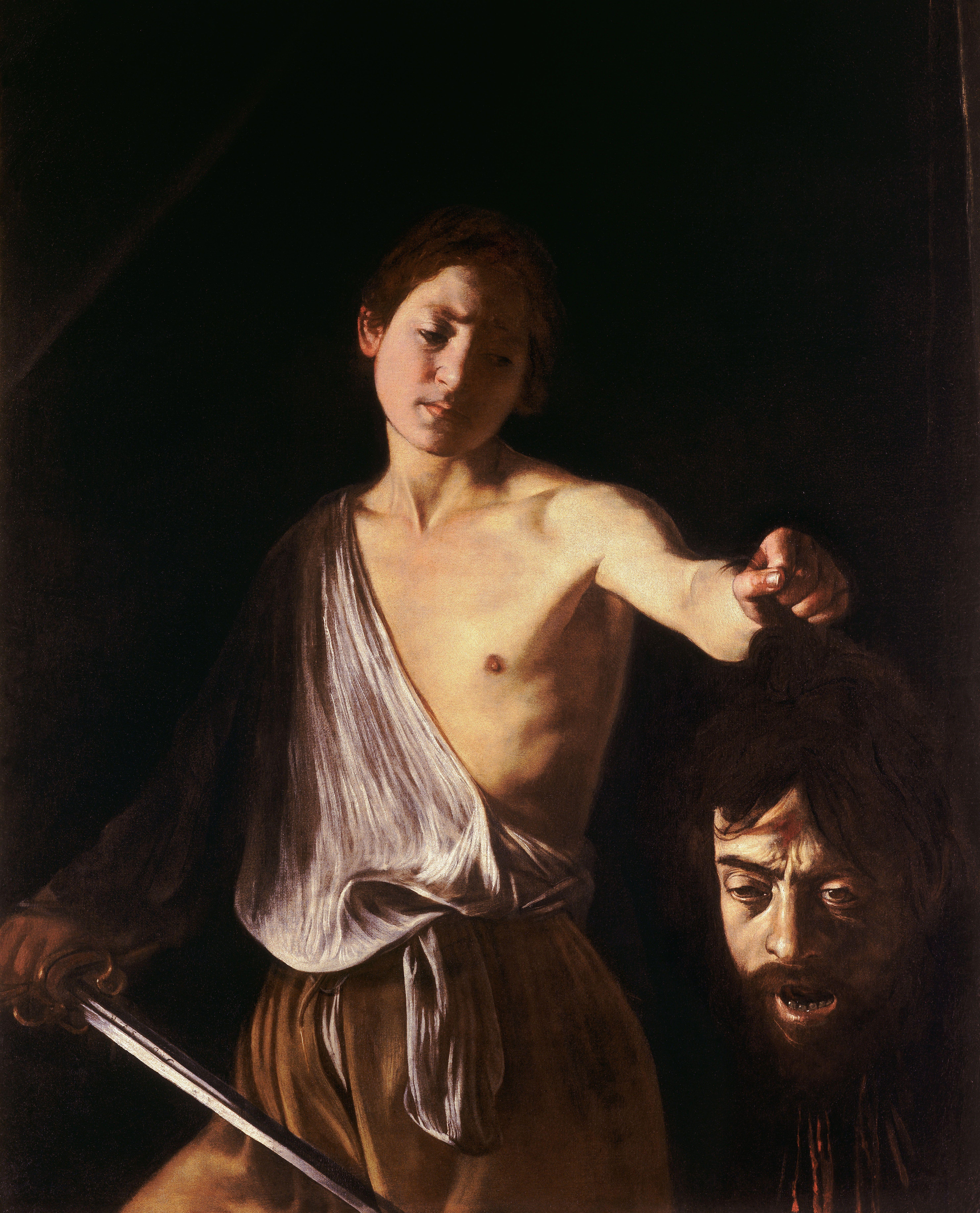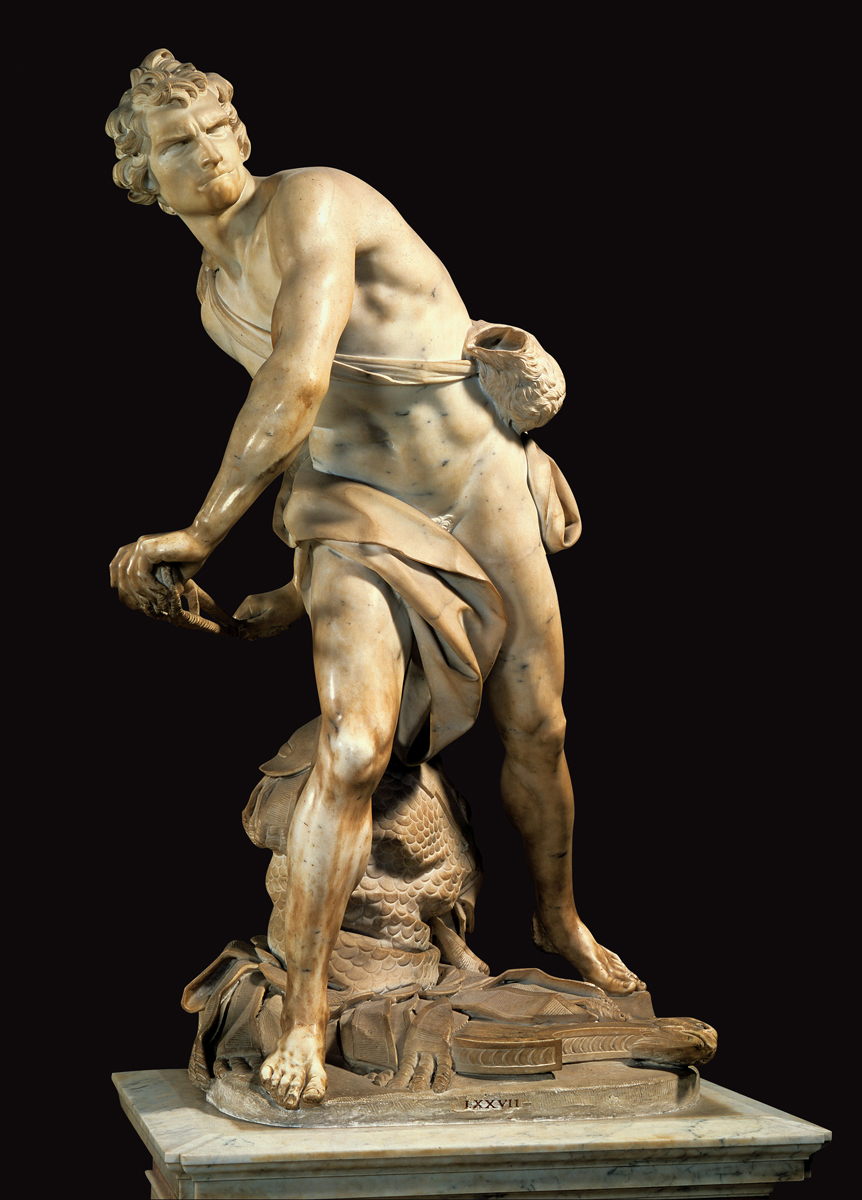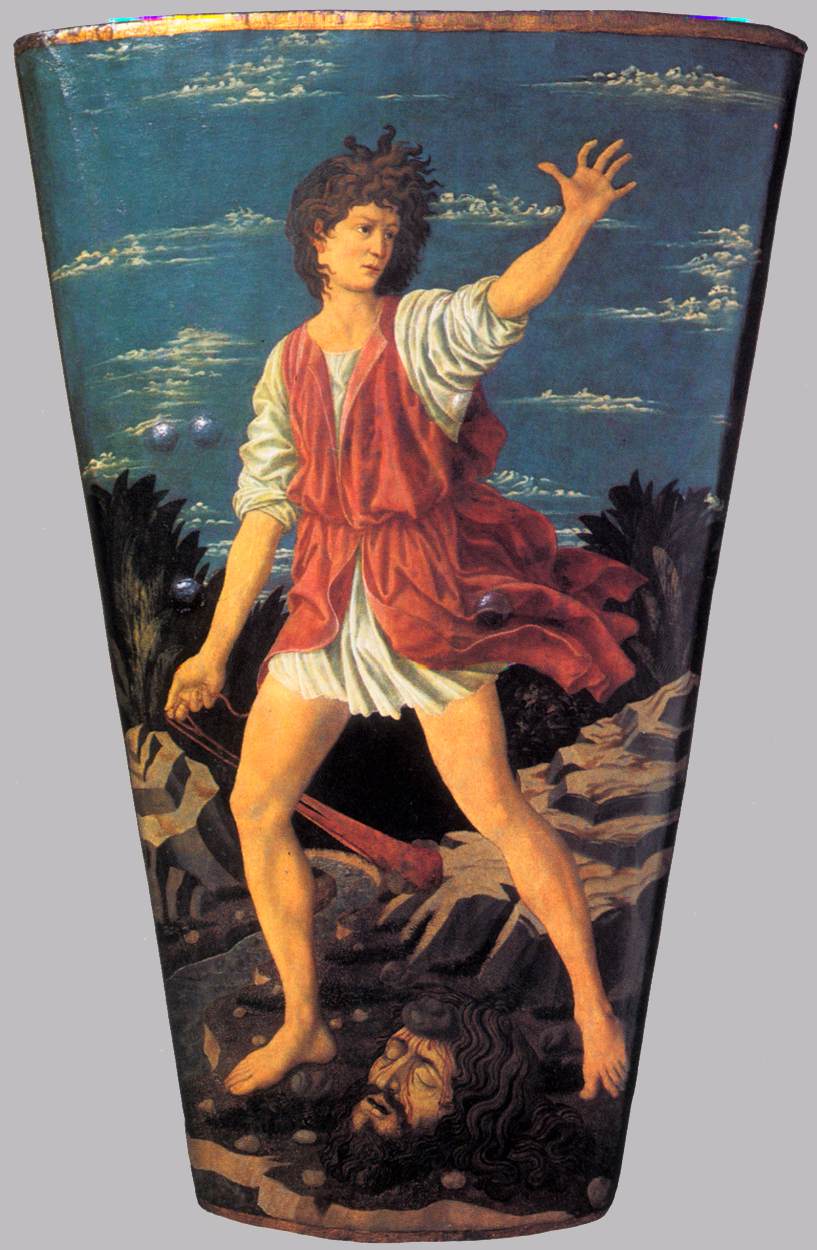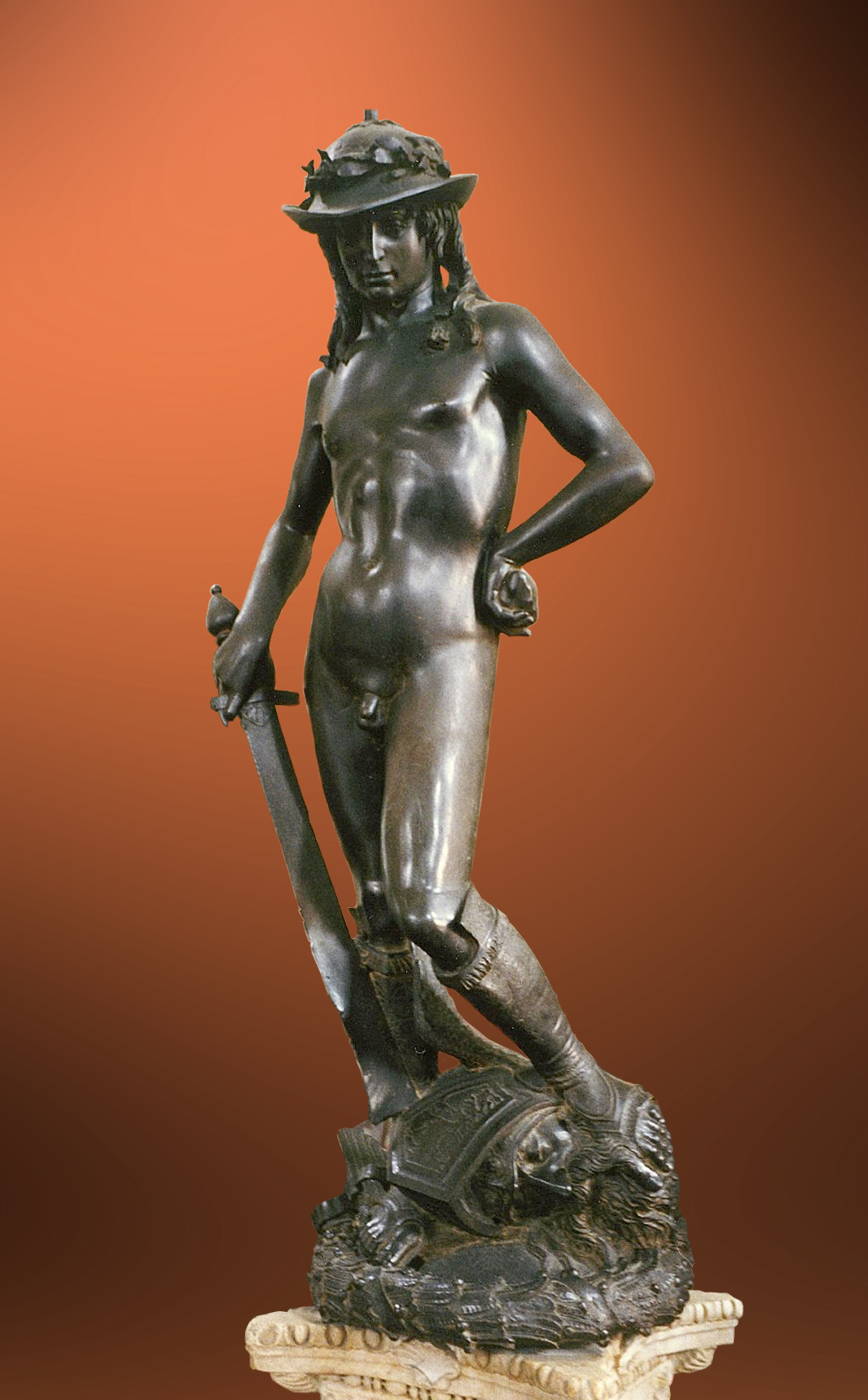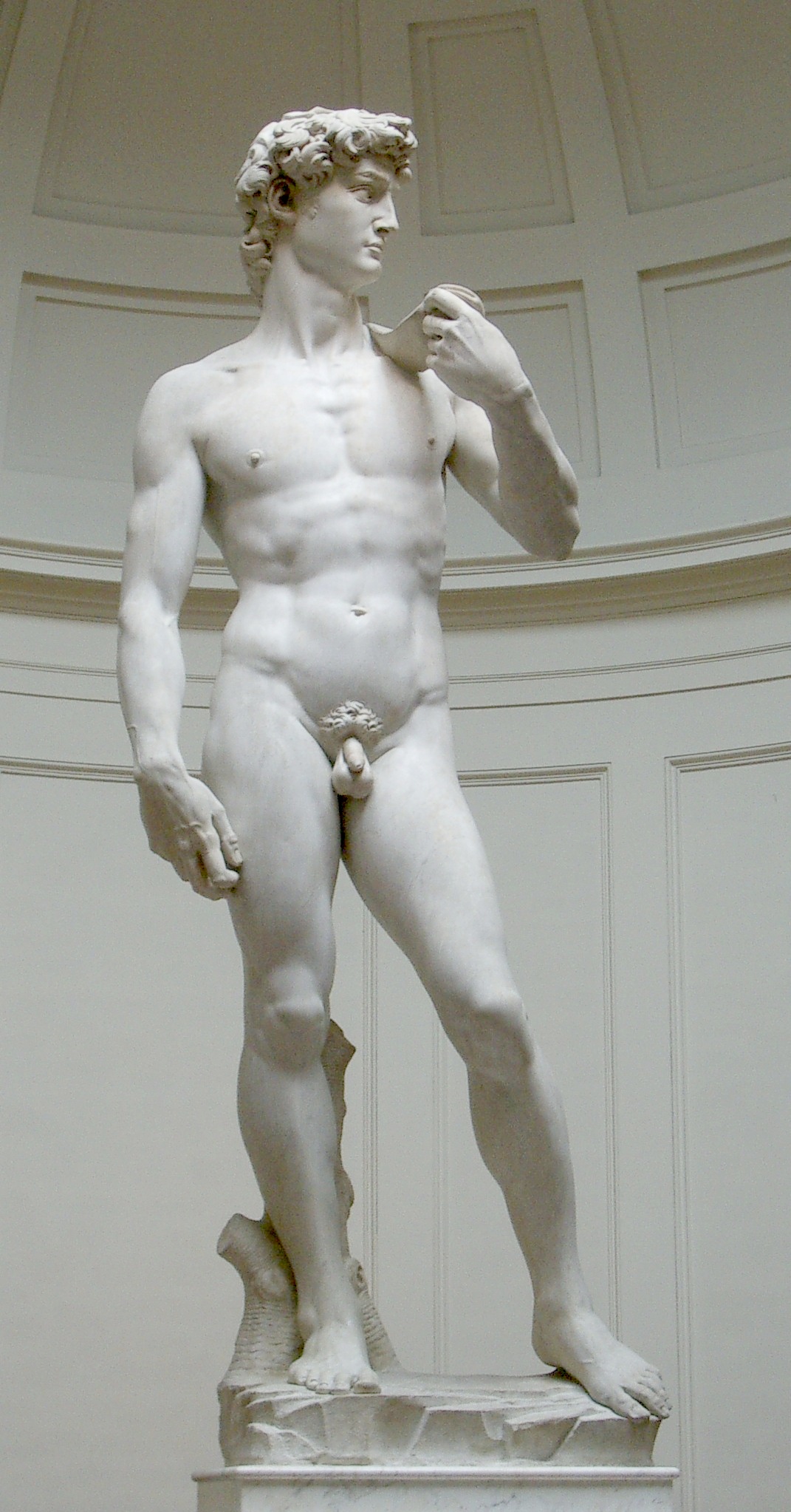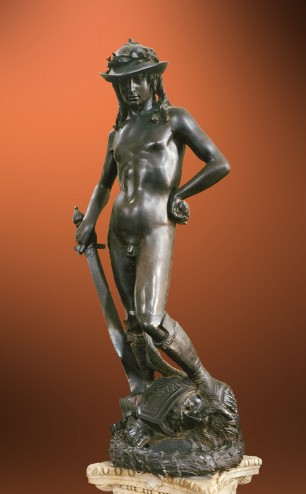 Donatello, David, 1428-32, bronze, Museo Nazionale del Bargello, Florence, 5’ 2¼”Photo by Patrick A. Rodgers via Wikimedia Commons, Public Domain, Creative Commons Attribution-Share Alike 2.0 License.
Donatello, David, 1428-32, bronze, Museo Nazionale del Bargello, Florence, 5’ 2¼”Photo by Patrick A. Rodgers via Wikimedia Commons, Public Domain, Creative Commons Attribution-Share Alike 2.0 License.
We can learn a great deal by looking at the same subject in art as it is represented over time. The similarities and differences speak volumes as to the true intentions of the artist and his or her cultural reality.
The Old Testament hero David first became a popular subject in Italian art during the early Renaissance because Florence had adopted him as a type of mascot. Florence was a major center for trade and finance, yet it was relatively small compared to the city-states of Rome, Milan, and Venice, so the city adopted David, who killed the giant Goliath with a slingshot, as a symbol of their city. David is the original victorious underdog.
The immensely powerful and wealthy Medici family were among the first Florentine art patrons to commission the subject, enlisting the young artist Donatello to sculpt the Old Testament figure to stand the courtyard in their huge palazzo. Donatello’s David, cast in bronze, was the first free-standing nude in the history of art since ancient times, an era that scholars at the Medici academy were intently studying. The sculpture, realistic in its representation of youth, is nevertheless stylized, adopting a contrapposto stance invented by the Ancient Greeks.
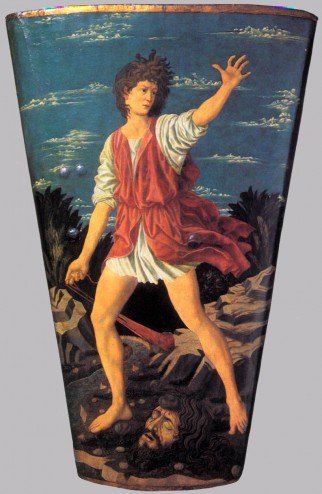 Andrea del Castagno, The Youthful David, c. 1450, tempera on leather mounted on wood, 45.5“ x 16.1”, National Gallery of Art, Washington, Public Domain via Wikimedia Commons.
Andrea del Castagno, The Youthful David, c. 1450, tempera on leather mounted on wood, 45.5“ x 16.1”, National Gallery of Art, Washington, Public Domain via Wikimedia Commons.
Andrea del Castagno painted The Youthful David on a leather shield that was intended for use in ceremonies, rather than on the battlefield. Normally coats of arms adorned these shields. Castagno painted the young and muscular David in action, his slingshot swinging behind his legs and the head of the monster Goliath at his feet. It is a perfect subject for this type of object.
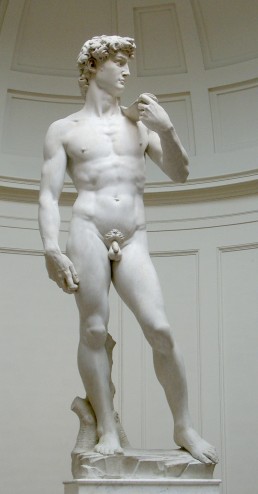 Michelangelo, David, 1501-1504, marble, 17’, Galleria dell’Accademia, Florence, Photo by Rico Hell via Wikimedia Commons, Public Domain, Creative Commons Attribution-Share Alike 3.0 License.
Michelangelo, David, 1501-1504, marble, 17’, Galleria dell’Accademia, Florence, Photo by Rico Hell via Wikimedia Commons, Public Domain, Creative Commons Attribution-Share Alike 3.0 License.
Michelangelo’s David is the most famous David in the world. It demonstrates both what art patrons valued and Michelangelo’s unique and personal working method. Carved from a single block of marble that was eighteen feet tall, Michelangelo’s buff David has an idealized physique that demonstrates just how much Renaissance artists admired the sculptures from Classical Greece; nevertheless, Michelangelo didn’t take everything from the ancients who adhered to strict mathematical proportions when rendering the human figure. Michelangelo always distorted his figures somewhat, trusting his artistic eye rather than laws of proportion for the human body that were based on mathematics. The head and hands on his David are rather large because Michelangelo knew that the sculpture would be installed on the buttress of the Florence Cathedral and he wanted a viewer to be able to see the head of his sculpture from far below because David’s expression carries the narrative content. The knit brows and the intense stare demonstrate Michelangelo’s unique narrative style that incorporates terribilità, which is the excitement of the moment just prior to the climax in a story.
The subject of David was popular with artists during the Baroque era in Rome more so that they could compete with Renaissance artists than anything else. There was no particular symbolic reason for Roman artists to render the subject.
In the Baroque era, artists present David in two different ways, representing each of the main stylistic movements of the period. While both of these sculptures emphasize drama, Gianlorenzo Bernini’s theatrical creation has an idealized, classical feel to it, whereas Caravaggio’s painting is raw and gritty.
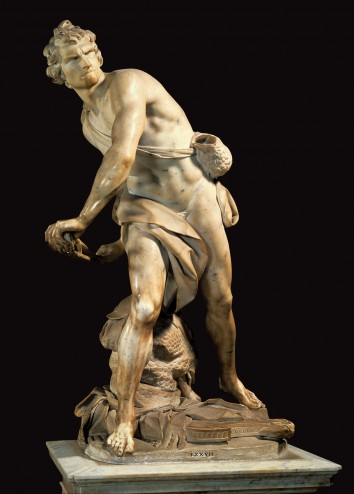 Gianlorenzo Bernini, David, 1623-24, marble, life-size, Galleria Borghese, Rome, Public Domain via Caravaggista, Creative Commons Attribution License.
Gianlorenzo Bernini, David, 1623-24, marble, life-size, Galleria Borghese, Rome, Public Domain via Caravaggista, Creative Commons Attribution License.
Gianlorenzo Bernini was a master of Baroque dynamism. His beautiful and strong David is more of a man than the adolescent described in the Old Testament, his form inspired by athletes in Classical Greek art. Bernini gives us a singularly exciting moment when David is winding way back with all of his strength so he can hurl the rock forward from his slingshot at Goliath. Bernini gives us a real sense of time – a split second moment with high energy. The sculpture breaks into our space, engaging us in the event, and involving us in the excitement. The execution of this sculpture is nothing less than a virtuoso performance; it’s hard to believe this sculpture is made of marble.
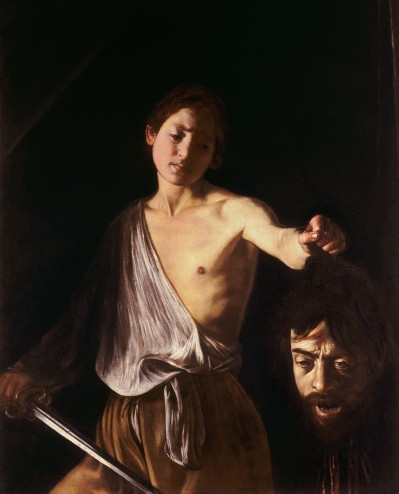 Michelangelo Merisi da Caravaggio, David with the Head of Goliath, c. 1610, oil on canvas, 49.2” x 39.4”, Galleria Borghese, Rome, Public Domain via Wikimedia Commons.
Michelangelo Merisi da Caravaggio, David with the Head of Goliath, c. 1610, oil on canvas, 49.2” x 39.4”, Galleria Borghese, Rome, Public Domain via Wikimedia Commons.
Caravaggio was the progenitor of the other Baroque style: the one with intense naturalism and contrasting lights and darks. The artist painted David a few times, but he created his most famous version during the later part of his career after he fled from Rome to escape murder charges and the Pope offered a cash prize for his head. Caravaggio was known for his stark realism, which was the result of using everyday people as models. Here, the slender boy emerges from the dark background to offer the grotesque severed head of Goliath to a viewer. The scene, which looks illuminated by a spotlight – the marked characteristic of his tenebrism – has an unusual sympathetic tone because David looks at Goliath with sadness and pity. Given the personal circumstances of the artist, it is tempting to see Goliath as a horrifying self-portrait, as if the artist was offering of his own head to the Pope in admission of guilt.

